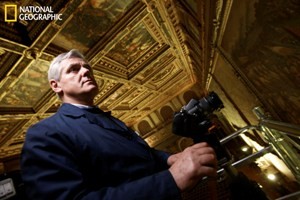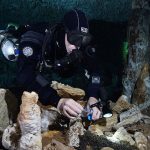Update from the Field: Search for Leonardo’s Lost Painting to Continue for Several Weeks
December 5, 2012 — [NOTE: The following is a statement from The City of Florence and the National Geographic Society (NGS) about recent progress made by UC San Diego researcher Maurizio Seracini and his team from the California Institute for Tele- communications and Information Technology (Calit2), who are in the midst of a high-tech search to find Leonardo da Vinci’s lost painting “The Battle of Anghiari.” The project is led by the National Geographic Society’s Expeditions Council and Univer- sity of California San Diego’s Center of Interdisciplinary Science for Art, Architecture and Archaeology (CISA3), in cooperation with the City of Florence. Also included here is National Geographic Magazine writer Tom O’Neill’s Dec. 4 dispatch from the Palazzo Vecchio, where the work is underway. The dispatch is reprinted with permission from NGS. The entire process is being documented for a National Geographic documentary premiering globally on National Geographic Channels worldwide begin- ning in mid-January. National Geographic magazine will also be reporting on the project. Additional updates on the project are available at: www.nationalgeographic.com/anghiari.
The City of Florence and the National Geographic Society are pleased to announce that the scaffolding housed in the Hall of 500 in Florence’s Palazzo Vecchio in support of the search for Leonardo’s “Battle of Anghiari” will remain in place for the next few weeks. This decision has been reached together with the various participating institutions, including the University of California at San Diego, the Florentine Superintendency for Cultural Assets and the Opificio dell Pietre Dure, the Italian art restoration agency based Florence, and will have multiple benefits.
The research, which is being carried out in compliance with all necessary regulations, is approved by MiBAC, the Italian Ministry for Cultural and Environmental Assets. The research was originally planned to take place between November 27 and December 3, 2011. The dismantling of the scaffolding was to begin in the early part of this week.
National Geographic will cover the costs associated with the Opificio’s request to maintain the scaffolding in place, The scaffolding will allow the Opificio to assess the state of conservation of and make any repairs to pre-existing fractures on the Vasari fresco.
Maurizio Seracini, ’73 (center), standing with the entire research team in front of the scaffold covering the Vasari fresco.
In terms of research status, we can further confirm the presence of a cavity — the only one present in all of Vasari’s frescoes in the Hall of This air gap has been detected in three different areas behind the Vasari, inspected through a sophisticated 4 mm probe kindly provided by Olympus and under the guidance of the Opificio.
In addition, the team has potentially identified a primer material on the original palazzo wall behind the Vasari mural. We expect to communicate further details from this exploratory phase once the laboratory analyses are completed, which we expect will be in the next few days.
Since 1888, National Geographic’s mission has been to promote research and geographic knowledge as well as cultural conservation through initiatives that contribute to a deeper understanding of the world.
The entire process is being documented for a National Geographic documentary premiering globally on National Geographic Channels worldwide beginning in mid-January. National Geographic magazine will also be reporting on the project.
Distinguished Guests Join Quest for Leonardo’s Missing Masterpiece
By Tom O’Neill, National Geographic Magazine
Night six came and went. The investigators from the University of California at San Diego gathered as they do every night before begin- ning their individual tasks: they stood on the scaffolding in front of a small color copy of Vasari’s fresco, the “Battle of Marciano,” and stared hard at the red and yellow dots scattered on the surface. These are the proposed entry points for inserting an endoscope to see if Leonardo’s own war mural, “The Battle of Anghiari,” still exists a few inches—and five centuries and countless obsessions—away behind a wall. Yellow represents priority sites, where project director Maurizio Seracini’s radar surveys have indicated voids—open areas close behind the Vasari wall, possibly where the supports of Leonardo’s scaffolding had been attached. In these spaces the endoscope would have comparative room to roam around, looking for telltale plaster and pigment. The red dots are also within the target area—a 4 x 3 meter area where the Leonardo painting, a fragment of a much larger planned mural, is believed to have been situated.

Maurizio Seracini inside the Palazzo Vecchio’s Hall of 500.
On and off through the night the back and forth of demand and compromise plays out, as Seracini argues for one of his dots as a new site for opening a hole in the Vasari fresco, and the restorers from the Opifio delle Pietre Dure, hands on chins, brows furrowed, shift their gazes between the colored print and the wall painting and propose other points, ones that will create less impact. Both sides have been infected by what photographer Dave Yoder calls the “Leonardo virus”—that fever to determine once and for all if one of his rare master- pieces (there are only some 15 authenticated Leonardo paintings in existence) remains behind the wall. The painting might survive only in fragments on a plaster wall or in pieces on the ground, both distinct possibilities given Leonardo’s experiment of painting the wall in oils, an inherently unstable process. Technology exists, restorers and Seracini say, to put the mural back together if the pieces are found.
But that’s looking far into the future. Tonight Seracini wants to probe one or two new holes. As bells in the dark city toll ten o’clock, Seracini has been granted his wish: permission for two new holes. So the work begins.
And so do the interruptions. A parade of distinguished visitors crosses the floor of the Salone de Cinquecentro below and one by one they climb the steps of the scaffolding to observe the progress of the audacious search. First to arrive is Florence’s young mayor, Matteo Renzi. This is the third time this week that Renzi has come. The first time he and his wife arrived straight from the opera—the “Barber of Seville.” Renzi, elected in 2009, has been an enthusiastic supporter of the National Geographic-led project, envisioning the possible display of the long-lost Leonardo as a keystone for the 500-year celebration in 2012 to honor the Florentine explorer and cartographer Amerigo Vespucci. On this night Renzi looked at endoscope images, asked to see potential future entry spots, and urged the researchers to settle this mystery. Then he rushed off, saying one of his children was sick. “If you find something, call me and I’ll come in my pajamas,” he said before leaving the hall.
Next up on the scaffolding was the Archbishop of Florence. He wore a dark overcoat with a large silver cross around his neck. Seracini briefed him on the project. Did he give a blessing, I afterward asked one of the Italian project coordinators? No, his presence alone was a prayer, came the answer. Listening to us, a city architect shrugged and said, “Maybe miracles happen in Naples,” he said, alluding to the devout superstitious nature of some of its citizenry, ”but not in Florence. Here we just have to keep working.”
At midnight Cristina Acidini came through the doors, elegantly dressed in black having come from a party. She is the superintendent of Florence’s public museums. She looked and listened intently as Seracini explained the latest developments. Answering questions afterward, she described the “Battle of Anghiari” as “Leonardo’s unfortunate masterpiece,” hidden for centuries. She hopes that the search will conclude with a definitive yes or no. That the Leonardo has survived and can be brought to light, or that it has disintegrated and nothing remains and the pursuit can end.
By one o’clock the old rhythm has reasserted itself. The researchers are taking samples and looking into holes. Maurizio even allows himself a smile. One probe has reached and entered the original back wall and spider webs and a green slug-like object appear on the monitor. The green object could be a piece of wax, who knows? In any event, since it appears beyond the Leonardo wall, it doesn’t count as any kind of evidence. We all stare anyway because we’re giddy from the long working hours and hey, there is something legible we can see behind the wall. Bells toll. Another visitor arrives. He carries boxes of take-out pizza.





